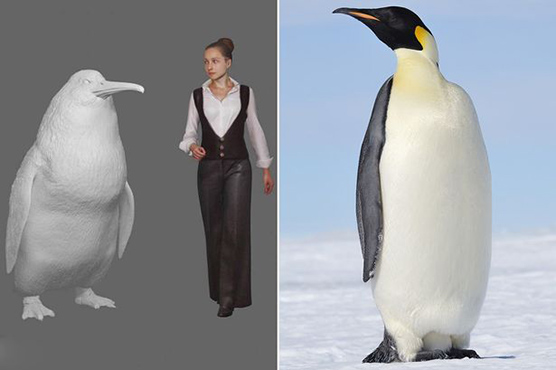Human-sized penguin fossil found in New Zealand

The length of the bones also allows them to infer the size of the entire penguin.
(Web Desk) – Researchers have found the remains of a beast that would have stood nearly as tall as a human, one of the biggest penguins to ever waddle the Earth in New Zealand – the ancient home of enormous parrots.
Paleontologists have named the penguin Crossvallia waiparensis, and it belongs to the Sphenisciformes order. It’s known from leg bones found in the Waipara Greensand fossil bed, where several other species of ancient Sphenisciformes have been found.
"The fossils discovered there have made our understanding of penguin evolution a whole lot clearer," said ornithologist Gerald Mayr of the Senckenberg Natural History Museum in Germany.
From the shape of these leg bones, paleontologists could tell that this new species is distinct from all the other giant penguins found at the site.
The length of the bones also allows them to infer the size of the entire penguin - and, yep, it’s a certified chonker.
It clocked in at around 1.6 metres (5’2") in height, and a hefty 70 to 80 kilograms (154 to 176 pounds). The animal lived between 66 and 56 million years ago, in the Paleocene, making it one of the earliest giant penguins, too.
It joins the ranks of such giants as Kumimanu biceae, discovered in 2017, which tipped the scales at 100 kilograms and stood 1.65 metres tall, and the biggest of them all, Palaeeudyptes klekowskii, which was 2 metres long and weighed 115 kilograms.
It’s also closely related to another extinct giant penguin found on another continent entirely - the Late Paleocene C. unienwillia, known from remains found on Seymour Island in Antarctica.
Back then, geological and palaeontological evidence suggests, the links between Australia, New Zealand and Antarctica were still pretty strong, with similar vegetation and wildlife. This similarity between the two penguins strengthens our understanding of how the continents were related tens of millions of years ago.
"When the Crossvallia species were alive," said Paul Scofield, a senior curator at Canterbury Museum, "New Zealand and Antarctica were very different from today - Antarctica was covered in forest and both had much warmer climates."
It also adds support to the hypothesis that penguins grew really big, really quickly in their evolutionary history, before shrinking back down again.
This shrinkage is thought to be related to the rise of sea mammals - seals, whales and others, competing for the same food resources and breeding grounds - which started to occur around the same time penguins started getting smaller.
The more fossils we find, the clearer the picture of the rise and fall of the penguins becomes. And the Greensand site is proving to be an incredibly rich source for this strange period in the history of the birds.
"There’s more to come, too - more fossils which we think represent new species are still awaiting description," Mayr said.
The paper describing the penguin has been published in Alcheringa: An Australasian Journal of Palaeontology.

